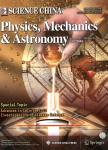版权所有:内蒙古大学图书馆 技术提供:维普资讯• 智图
内蒙古自治区呼和浩特市赛罕区大学西街235号 邮编: 010021

作者机构:National Astronomical ObservatoriesChinese Academy of SciencesBeijing 100101China School of Astronomy and Space SciencesUniversity of Chinese Academy of SciencesBeijing 100049China Department of PhysicsUniversity of Hong KongPokfulam RoadHong Kong 999077China Key Laboratory of Particle AstrophysicsInstitute of High Energy PhysicsChinese Academy of SciencesBeijing 100049China Department of Astrophysics/IMAPPRadboud UniversityNijmegen6500 GLthe Netherlands SRONNetherlands Institute for Space ResearchLeiden2333 CAthe Netherlands ESA/ESTECNoordwijk2201 AZthe Netherlands Max Planck Institute for Extraterrestrial PhysicsGarching85748Germany School of Physics and AstronomyUniversity of LeicesterLeicesterLE17RHUK INAF-Istituto di Astrofisica e Planetologia SpazialiRome00133Italy Institute of Space Sciences(ICE)CSICCampus UABBarcelonaE-08193Spain Institut d’Estudis Espacials de Catalunya(IEEC)BarcelonaE-08034Spain Department of AstronomyXiamen UniversityXiamen 361005China Purple Mountain ObservatoryChinese Academy of SciencesNanjing 210023China School of Astronomy and Space SciencesUniversity of Science and Technology of ChinaHefei 230026China Nevada Center for AstrophysicsUniversity of NevadaLas VegasNV 89154USA Department of Physics and AstronomyUniversity of NevadaLas VegasNV 89154USA Department of AstronomySchool of Physics and TechnologyWuhan UniversityWuhan 430072China School of Physics and AstronomyYunnan UniversityKunming 650500China Xinjiang Astronomical ObservatoryChinese Academy of SciencesUrumqi 830011China Universit´e Paris Cit´eCNRSAstroparticule et CosmologieParisF-75013France Department of AstronomyUniversity of Science and Technology of ChinaHefei 230026China Institute for Frontier in Astronomy and AstrophysicsBeijing Normal UniversityBeijing 102206China Department of AstronomyBeijing Normal UniversityBeijing 100875China INAF-Osservatorio Astronomico di BreraMerate(LC)I-23807Italy INFN-sezione di Milano-BicoccaMilano(MI)I-20126Italy Dipartimento di FisicaUniversit`a di Roma“Sapienza”Roma I-00185Italy Institut de Recherche en Astrophysique et Plan´etologieUPS-OMPCNRSCNESToulouse Cedex 4F-31028France Yunnan ObservatoriesChinese Academy of SciencesKunming 650216China Key Laboratory for the Structure and Evolution of Celestial ObjectsChinese Academy of SciencesKunming 650216China School of Astronomy and Space ScienceNanjing UniversityNanjing 210023China Key Laboratory of Modern Astronomy and Astrophysics(Nanjing University)Ministry of EducationNanjing 210023China School of Physics and AstronomySun Yat-sen UniversityZhuhai 519082China Max-Planck-Institut f¨ur RadioastronomieBonn53121Germany Institute for Cosmic Ray ResearchThe University of TokyoKashiwa CityChiba277-8582Japan Key Laboratory of Stars and Interstellar MediumXiangtan UniversityXiangtan 411105China Institute of AstrophysicsCentral China Normal UniversityWuhan 430079China Key Laboratory of Quark and Lepton Physics(Central China Normal University)Ministry of EducationWuhan 430079China College of Physics and Hebei Key Laboratory of Photophysics Research and ApplicationHebei Normal UniversityShijiazhuang 050024China Observatoire Astronomique de StrasbourgUniversit´e de StrasbourgCNRSStrasbourgF-67000France INAF-Osservatorio Astrofisico di TorinoPino TorineseI-10025Italy Sydney Institute for AstronomySchool of Physics A28The University of SydneyNSW 2006Australia School of Earth and Space SciencesPeking UniversityBeijing 100871China Department of PhysicsUniversity of Rome“Tor Vergata”RomeI-00133Italy School of Physics and State Key Laboratory of Nuclear Physics and TechnologyPeking UniversityBeijing 100871China Kavli Institute for Astronomy and AstrophysicsPeking UniversityBeijing 100871China
出 版 物:《Science China(Physics,Mechanics & Astronomy)》 (中国科学:物理学、力学、天文学(英文版))
年 卷 期:2025年第68卷第3期
页 面:1-60页
核心收录:
学科分类:07[理学] 070401[理学-天体物理] 0704[理学-天文学]
基 金:supported by Strategic Priority Program on Space Science of Chinese Academy of Sciences,in collaboration with ESA,MPE and CNES(Grant Nos.XDA15310000,and XDA15052100) supported by the National Natural Science Foundation of China(Grant Nos.61234003,61434004,and 61504141) CAS Interdisciplinary Project(Grant No.KJZD-EW-L11-04)
主 题:Einstein Probe X-ray astronomy X-ray telescopes time-domain astronomy transients variability
摘 要:The Einstein Probe(EP)is an interdisciplinary mission of time-domain and X-ray *** with a wide-field lobstereye X-ray focusing imager,EP will discover cosmic X-ray transients and monitor the X-ray variability of known sources in 0.5-4 keV,at a combination of detecting sensitivity and cadence that is not accessible to the previous and current wide-field monitoring *** can perform quick characterisation of transients or outbursts with a Wolter-I X-ray telescope *** this paper,the science objectives of the EP mission are *** is expected to enlarge the sample of previously known or predicted but rare types of transients with a wide range of *** them,fast extragalactic transients will be surveyed systematically in soft X-rays,which includeγ-ray bursts and their variants,supernova shock breakouts,and the predicted X-ray transients associated with binary neutron star *** will detect X-ray tidal disruption events and outbursts from active galactic nuclei,possibly at an early phase of the flares for *** will monitor the variability and outbursts of X-rays from white dwarfs,neutron stars and black holes in our and neighbouring galaxies at flux levels fainter than those detectable by the current instruments,and is expected to discover new objects.A large sample of stellar X-ray flares will also be detected and *** the era of multi-messenger astronomy,EP has the potential of detecting the possible X-ray counterparts of gravitational wave events,neutrino sources,and ultra-high energyγ-ray and cosmic ray *** is expected to help advance the studies of extreme objects and phenomena revealed in the dynamic X-ray universe,and their underlying physical *** EP s strength in time-domain science,its follow-up telescope,with excellent performance,will also enable advances in many areas of X-ray astronomy.